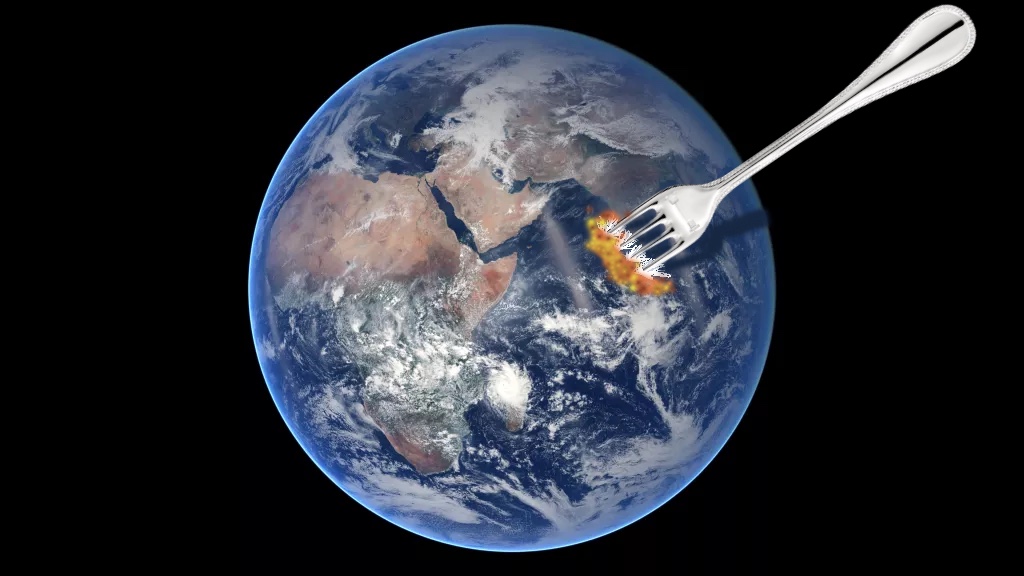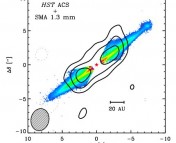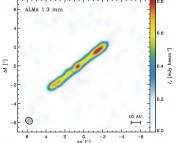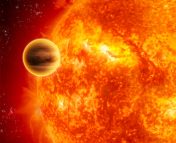
Title: Chemical evidence for planetary ingestion in a quarter of Sun-like stars
Authors: Lorenzo Spina, Parth Sharma, Jorge Meléndez, Megan Bedell, Andrew R. Casey, Marília Carlos, Elena Franciosini, Antonella Vallenari
First Author’s Institution: INAF – Osservatorio Astronomico di Padova, Italy
Status: Published in Nature
Did you know that stars get hungry, too? Lucky for us, our Sun hasn’t had a taste for planets yet. The relatively circular and stable orbits on which our Solar system’s planets reside means that they (we) are safe from our Sun’s hungry grasp (for now). But other planetary systems aren’t as lucky. Stellar systems with turbulent initial conditions can create planets on dynamically unstable, highly eccentric orbits that cause the planet to plunge into the host star.
How often does this fiery, rocky feast actually happen? And inversely, how common is it to find a star like our Sun that is able to host such a dynamically peaceful system? These questions are important for not only planet formation theory but also the search for life outside our Solar system. Today’s authors set out to address these important questions by searching for chemical signs of planet engulfment in Sun-like stars.
You are what you eat
As far as we understand, planets form in the protoplanetary disk that surrounds a young star. This disk is made of gas, dust, and ice, and largely contains the same abundances of elements found in the central star. As time passes, refractory elements are the first to condense and clump up, forming rocky planetesimals and eventually planets, while volatile elements tend to remain in gaseous form for longer. Refractory elements are those with high condensation temperatures, whereas volatile elements are those with low condensation temperatures. This means that at the 500 to 1500 K temperatures of the inner protoplanetary disk, refractory elements will be able to condense and form planets whereas volatile elements will remain largely in a gaseous form. This leads to rocky planets and the cores of gaseous planets being primarily composed of refractory elements. The remaining volatile element-rich gas from the protoplanetary disk that hasn’t been trapped by a newly-formed planet is eventually dissipated.
Now that we know what planets are made of, we can infer what chemical changes occur in a star that has just had a meal. When a star eats a planet, the host star becomes chemically enriched in refractory elements compared to what it was pre-meal thanks to the refractory-rich rocky material entering its system. This means that we might be able to tell when a star has had a planetary feast by comparing its presently-observed chemistry with its initial, pre-meal chemistry! But how can we tell what its pre-meal chemical composition was? Today’s authors cleverly address this question using wide binaries.
Wide binaries help decipher pre-meal composition
Wide binaries are pairs of stars that are gravitationally bound and thus orbiting a common center of mass. The wide part means that their semi-major axes of orbit are large enough for each member to be resolved, so we can study each star in the pair separately. It is understood that binary stars are born together, at the same time, of the same molecular cloud. Because they were born together, we expect them to look chemically identical. This is because molecular clouds are turbulent in nature, mixing up their contents really well prior to the start of star formation, so stars born in the same region of the cloud should be quite chemically similar. Therefore, any differences in the observed compositions of stars in a binary pair are either due to differences in the stellar parameters (such as effective temperature, surface gravity, and the mass of the convective envelope, which don’t alter the true, intrinsic chemical abundances of a star but rather the abundances we observe/derive) or due to an event that occurred after the star was formed, such as a planetary engulfment. To limit the effects of the former and maximize the likelihood that any observed differences in chemical composition are due to the latter, today’s authors choose wide binary systems where both members share similar stellar parameters.
With all this said, we now understand why the authors of today’s paper chose wide binaries: assuming only one star in the binary ingests a planet, we can use the other star as a calibration tool to trace the initial composition of the hungry star. For this investigation, the authors chose 107 wide binary pairs composed of stars with effective temperatures and surface gravities similar to those of the Sun. They then studied how chemically similar stars within each pair were to each other. The authors used iron as their element of choice to probe chemical similarity among stars in each binary. Iron is a great choice because 1), iron abundances can be measured to high precision due to the element’s many absorption lines in stellar spectra, and 2), iron is a refractory element and thus can be used as a proxy for rocky planet material.
30% of stars in observed wide binaries had a planetary meal
The authors find that nearly a third of their 107 binary pairs they investigate show significant (> 2 sigma) chemical differences between their members (see Figure 1 and associated caption). In addition, they find that hotter binary pairs (those approaching 6,000 K) are more likely to show chemical differences between members of the pair.
How do we know that these chemical differences are due to one of the members of the pair engulfing a planet? Well, first of all, the temperature dependence in Figure 1 is a good sign. The authors suggest that this temperature dependence may be rooted in the physics of stellar structure. Stars with masses between 0.4 and 1.3 that of Solar (i.e., the stars in this study) have convective envelopes that are constantly mixing up the contents of its envelope like a blender. The thickness of this convective envelope is inversely proportional to the star’s mass (and, subsequently, its temperature). In other words, cooler, lower-mass stars have thicker convective envelopes that are more efficient at mixing up gas at the stellar surface than their higher-mass brethren, which have thinner convective envelopes. This means that if we would drop a planet at the surface of a cooler star, the chemical signature of that planet, namely the increase in the abundance of refractory elements like iron, would be efficiently mixed away deep into the star’s interior, and the chemical signs of planetary engulfment would weaken significantly. However, if we were to repeat this with a hotter star that has a thinner convective envelope, we would be able to see chemical signs of engulfment much more easily, and possibly for longer, due to the thin envelope that doesn’t mix planetary contents as deep into the star. This could explain the relationship between temperature and the probability of finding chemically different pairs of binary stars. To further explore this relationship, the authors simulate a mock sample of binaries with a range of temperatures and thus a range of convective envelope thicknesses. If they assume a likelihood of planet engulfment of 27%, something they derive from their observations, they are able to recreate the relationship between temperature and the probability of finding a chemically dissimilar binary pair with their simulated data (dashed lines in Figure 1).
To further explore the potential that the chemical differences in their binary pairs are due to planetary engulfment events, the authors observe the ratio of [Fe/C] in each member of the chemically different binary pairs. They chose this particular ratio of elemental abundances because it probes the abundance ratio of refractory (iron) elements to volatile (carbon) elements. An increased [Fe/C] relative to the expected value in Sun-like stars of the same metallicity might be caused by the engulfment of a refractory element-rich planet. The authors find that, in most of the chemically-different binary pairs, the slightly more metal rich component tends to have the increased [Fe/C] abundance (see Figure 2). This strongly suggests that engulfed rocky material is responsible for the chemical difference between the members of the pairs.
Overall, the authors of today’s paper find that 27% of Sun-like stars in wide binaries show signs of planetary engulfment. Furthermore, when studying these chemical differences, they find that the more metal-rich component of the binary was likely to be involved in the planetary ingestion. Finally, they found that it is easier to detect a star that has eaten a planet when it is on the hotter-side, around 6,000 K, give or take 500 K. These results emphasize the power that stellar chemistry holds in the study of exoplanets. In addition, the authors take an initial step towards studying observationally the probability of finding dynamically peaceful solar systems like our own, something that plays an important role in our search for extraterrestrial life. These results open up the door to future studies further examining the occurrence rate of planetary ingestion by host stars. It would be particularly interesting to determine whether one fourth of all stars host dynamically unstable planetary systems, or whether this result is unique to stars in binary systems. Furthermore, it would be interesting to expand this study to unresolved binaries and explore whether binary separation has an effect on the likelihood of planetary ingestion.
Edited by: Alison Crisp
Featured image credit: NASA Earth Observatory/ Robert Simmon/ Suomi NPP VIIRS imagery/ NOAA’s Environmental Visualization Laboratory/ Christofle/ Catherine Manea




